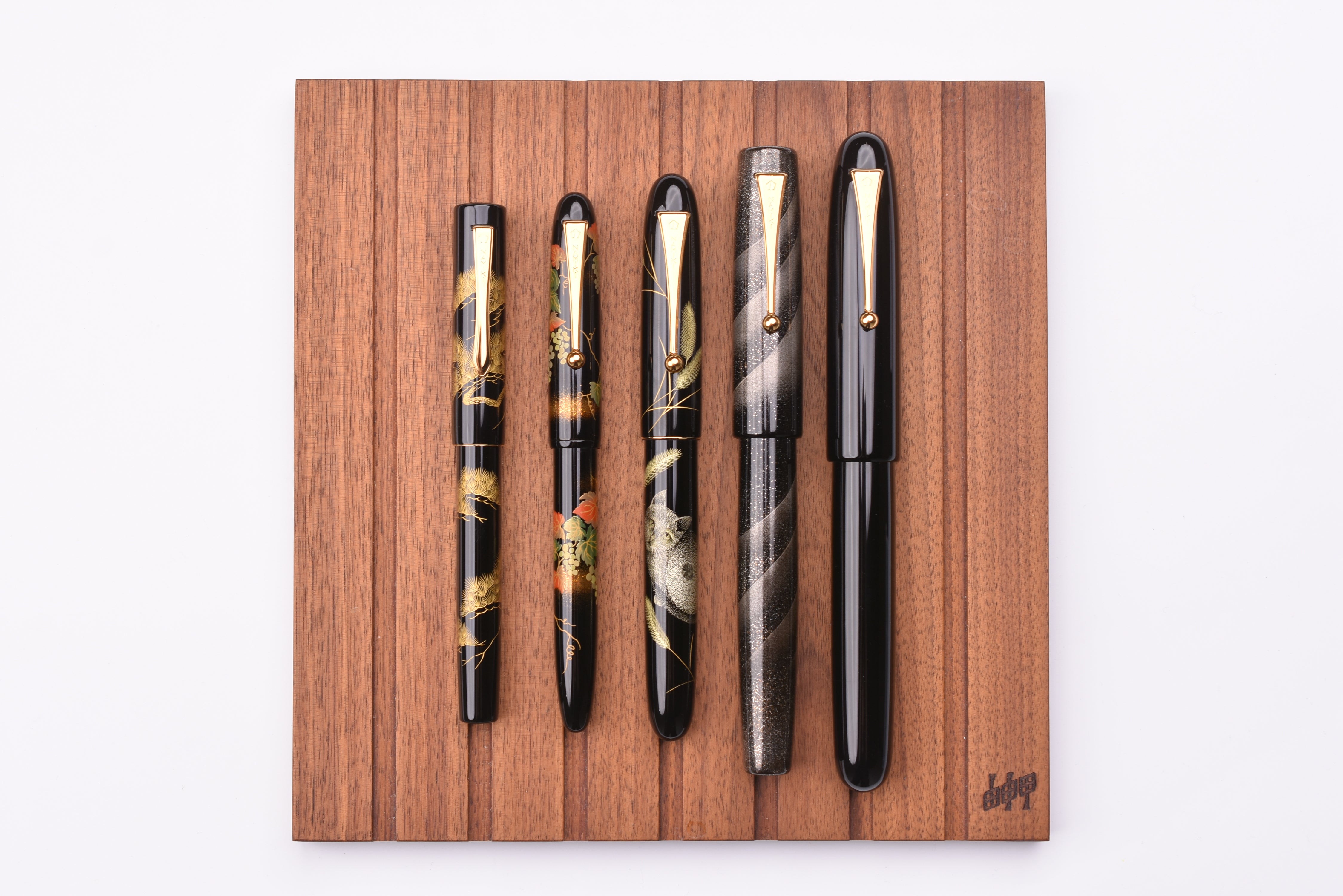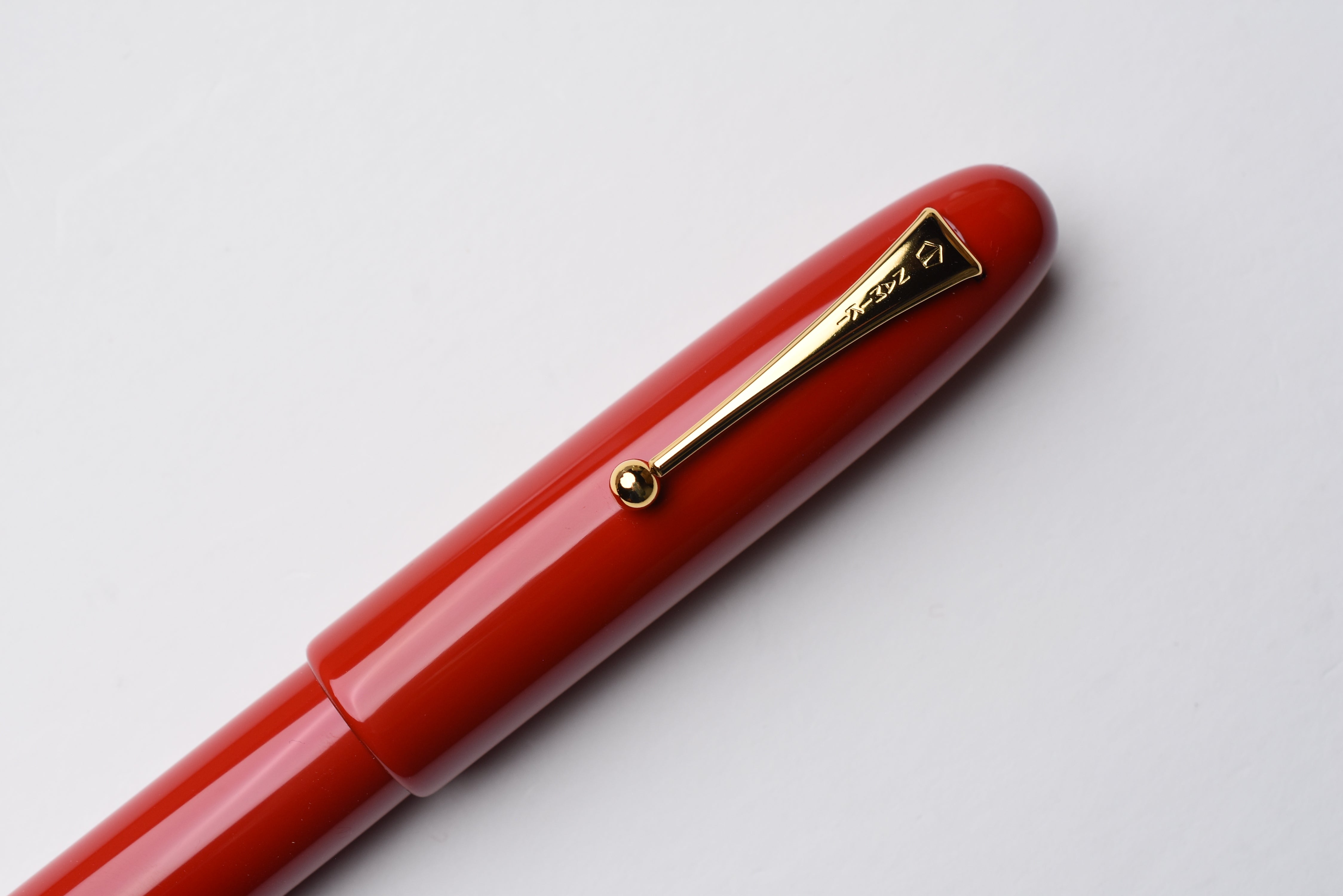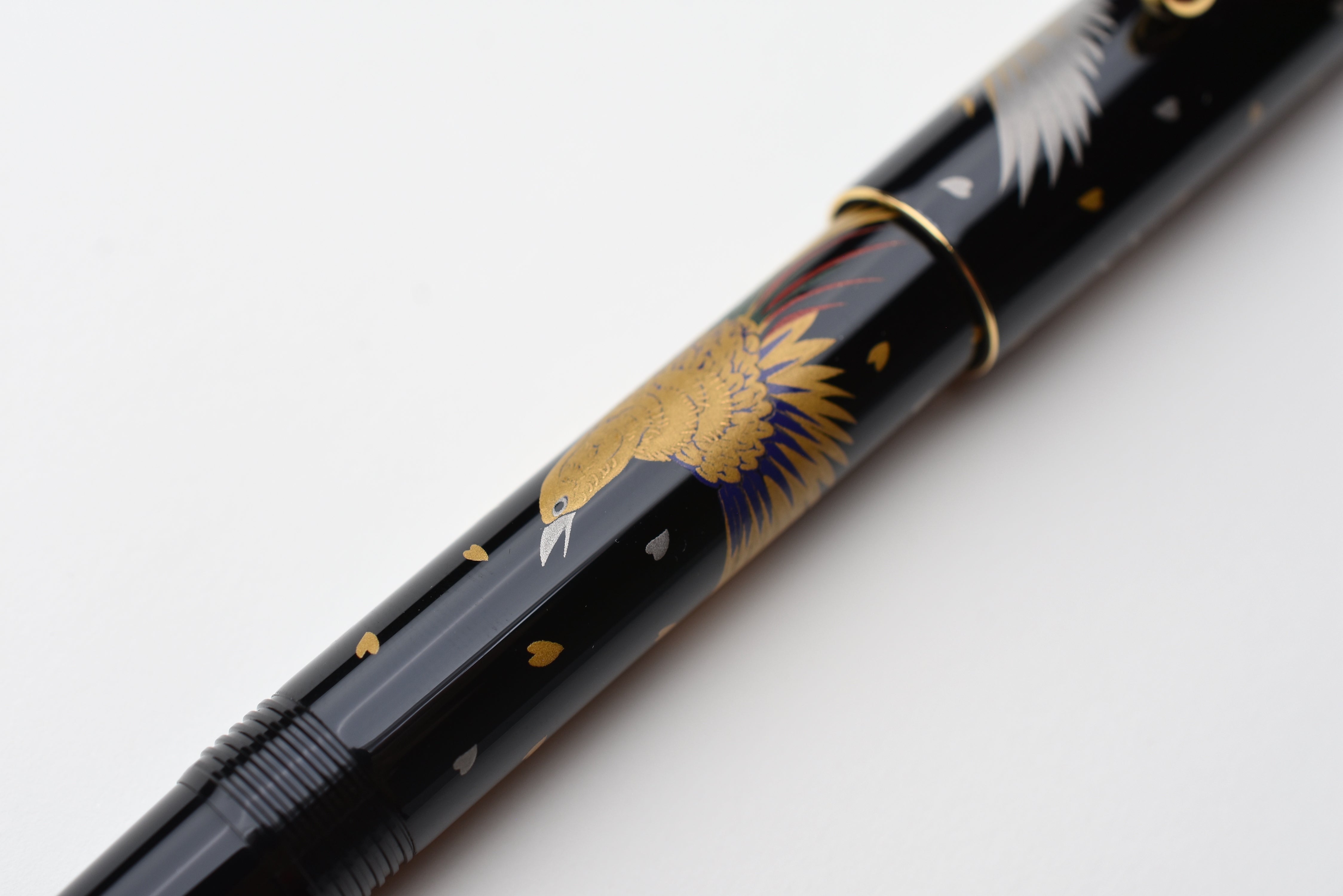“Why is this pen so expensive?” We (understandably) get asked this question a lot at Yoseka, especially when it comes to gold-nib and maki-e fountain pens. While there are a lot of answers to this question—from the lower demand for this relatively niche market limiting the scale of production to the specifics of various brands—in this post I (Amy—hi!) am going to focus on Pilot’s Namiki fountain pens.
Namiki was founded in Japan in 1925 as part of Pilot and focuses on handmade maki-e pens, especially fountain pens, that use urushi lacquer, metal powders, and other precious materials to create unique and intricate designs. Each maki-e pen is a distinct work of art that features the signature of the artist who completed it.
Urushi Lacquer
Urushi lacquer is produced from sap harvested from the Toxicodendron vernicifluum (Japanese lacquer tree), a practice dating back thousands of years in East Asia. Sap can only be harvested from mature trees that are 10-15 years old; during harvesting season (June to September), these trees are tapped every 4-5 days, and each tree will only yield about 100-200ml (less than one cup) of sap across these months. After the end of the season, the trees are usually cut down so that new trees can be planted. This makes urushi lacquer a costly and scarce resource.
In its raw liquid form, urushi sap often induces severe rashes and must be handled with care. Once refined and cured (rather than drying, the sap polymerizes in a humid environment at around 25 degrees Celsius) over the course of 12-24 hours, it forms a glossy finish that is durable and waterproof (and only very rarely causes adverse reactions). As this process can sometimes be repeated dozens of times as layers are added, a single pen can take months to complete. Often urushi lacquer is applied in tandem with maki-e techniques (see below); the lacquer can also be colored with pigments such as iron oxide.
In Namiki’s Urushi Collection, Roiro Urushi Shiage (non-oil lacquer finish) is used to highlight the beauty and depth of the lacquer itself without the added ornamentation of maki-e art. In Roiro Urushi Shiage, the most time-consuming polishing technique, raw lacquer is repeatedly rubbed onto the pen and polished with charcoal of various sizes to create a beautifully glossy finish.
(Detail of Namiki Emperor Vermilion Urushi)
Maki-e Techniques
“Maki-e” literally translates to “sprinkled picture” in Japanese, referencing the process of creating a detailed image with lacquer and metal powders. Maki-e involves drawing a design in lacquer on a dry lacquered surface. Gold and other precious metal powders are then sprinkled onto the wet lacquer using a bamboo tube; after drying, the remaining powder is brushed away and the image is sealed with another layer of lacquer. This lacquering, drawing, sprinkling, and polishing are repeated until the final design has been realized—sometimes after dozens of layers.
Namiki fountain pens are handcrafted by the artisan group Kokkokai, which formed in 1931 around the renowned maki-e artist Gonroku Matsuda. Each pen features the group’s name or the signature of the individual artisan who created it (a list of the artisans comprising Kokkokai, as well as images of their signatures, can be found on the Pilot-Namiki website here).
Hira Maki-e (Flat Maki-e)
(Detail of Namiki Nippon Art Golden Pheasant)
Hira Maki-e is a basic maki-e technique in which the design is drawn in lacquer and sprinkled with gold and other metal powders. After the excess powder is removed, layers of clear lacquer are applied to seal the image, then burnished.
Togidashi Maki-e (Burnished Maki-e)
(Detail of Namiki Aya Hayate Black)
In Togidashi Maki-e, Hira Maki-e is used to create the image, then the entire pen is covered with black urushi lacquer. After the lacquer dries, the surface is lightly burnished with charcoal until the gold powder becomes visible; lastly, additional coats of raw lacquer are applied to seal the image and create a glossy finish.
Togidashi-Hira Maki-e (Burnished-Flat Maki-e)
(Detail of Namiki Yukari Flower Fence)
After the background and scenery are completed using Togidashi Maki-e, the main features are added with Hira Maki-e, creating subtle depth.
Togidashi-Taka Maki-e (Burnished-Raised Maki-e)
This advanced technique combines Togidashi Maki-e, Hira Maki-e, and Taka Maki-e (Raised Maki-e). After the background and secondary elements are rendered through Togidashi Maki-e, Taka Maki-e builds up the surface of the image using lacquer and charcoal powder, making a raised, three-dimensional image. Then Hira Maki-e is used to finish the design, accomplishing even greater detail and depth. (Namiki’s website provides fascinating insight into this process here.)
Chinkin (Gold Inlay)
Chinkin, the technique showcased in Namiki’s Chinkin Collection, is not a maki-e technique. Rather than being created through the sprinkling of metal powder on a flat surface where a design has been painted in lacquer, these designs are made by carving dots and lines into a lacquered surface with chisels; after rubbing wet lacquer in these grooves, gold leaf and gold powder are inlaid into them. After drying, the excess powder is wiped away and the design is sealed with more lacquer. Chinkin pens have a textured surface from this carving process, and upon close examination, the shading in these illustrations is composed of tiny, precise dots. (Namiki’s website offers descriptions and photos of each step here.)
Raden (Abalone-Shell Inlay)
(Detail of Namiki Yukari Firefly)
Raden involves adhering pieces of the iridescent lining of abalone shells to a lacquered surface; the fragments are then lacquered over and burnished to seal them and create a smooth surface. Raden is often used in collaboration with maki-e techniques to splendid effect, as in Namiki Yukari Firefly.
Nib and Body Material
The fountain pens in Namiki’s collections feature 14-karat or 18-karat gold nibs and bodies made of metal or ebonite, which are then coated with urushi lacquer. While Namiki’s smaller Yukari pens are made of brass, their larger pens, such as the Aya and Emperor pens, have more lightweight ebonite barrels under their lacquer coating.
Ebonite, or hard rubber, was originally intended as a replacement for ebony wood. It is formed when rubber is heated with sulfur in a process called vulcanization. Vulcanized rubber is extremely durable and chemical-resistant. It is significantly lighter than metal, making even Emperor-sized pens a comfortable weight to write with; it also warms to the touch, giving it an organic feeling in the hand unlike plastic pens. Ebonite feeds, a feature of the Urushi Emperors, have an additional advantage—their textured surfaces are more conducive for ink flow and they can be molded with heat to fit the nib more accurately. However, ebonite feeds have to be hand-tooled, making them much slower and costlier to produce than the usual plastic feeds.
Ebonite does have its drawbacks: the color can dull and degrade over time, especially when exposed to light for extended periods. To counteract this, Namiki began to coat their ebonite pens with urushi lacquer due to its protective properties and smooth, glossy finish, then progressed a step further to creating maki-e designs on the barrels; now maki-e pens are made from other materials as well, including metal. The results are durable and unique works of art.
Namiki fountain pens generally come in several distinct body sizes: the Yukari, Yukari Royale, and Emperor. The pens in the Aya Collection, which launched in February 2023, pioneer a new size that falls between the Yukari Royale and the Emperor, making them the second-largest Namiki pens. Larger body sizes, especially the Emperor model, allow for more elaborate maki-e designs, adding to the value of the pen through time, labor, and craftsmanship.

(Left to right: Namiki Chinkin Pine Tree [Yukari with flat ends]; Namiki Yukari Grapevine [rounded ends]; Namiki Chinkin Cat; Namiki Aya Hayate Black; Namiki Emperor Black Urushi)
These body sizes, which can come with rounded or flat ends and with or without a clip depending on the pen, also correspond with the pens’ nib sizes (the actual physical size of the nib rather than the line width): Yukari fountain pens (this includes some pens in the Nippon Art Collection and the Chinkin Collection, etc.) typically have a #10 nib, the Yukari Royale has a #20 nib, the Aya a #30 nib, and the Emperor a #50 “Jumbo” nib.
Most fountain pen nibs are made of steel, which tends to be stiff, inflexible—and inexpensive. But Namiki’s pens, and many other luxury fountain pens, often feature nibs made of gold. This isn’t just for the “luxury” label—because gold is a much softer metal than steel, it creates a smoother, bouncier writing experience. While both gold and steel nibs are usually tipped with a harder metal, iridium, to protect the tip from wearing down, the flexibility of a gold nib lets the tines spread more, allowing for more line variation and expressiveness (though to avoid permanently damaging the nib, it’s best not to push this too much). In addition, gold is more resistant to corrosion (ex. from acidic inks), so gold nibs may wear better over time.
Some of these nibs, such as the #10 used for the Nippon Art Collection, are made of single-tone 14-karat gold, while the pens in the Yukari Collection have two-tone (bicolor) 18-karat gold #10 nibs. Meanwhile, the #50 nib of the Namiki Emperor, in addition to being the largest, features a higher gold content at 18 karats, increasing the material cost.

(Pilot Namiki nib size comparison. Left to right: #5 - Pilot Custom 74; #10 - Namiki Yukari; #15 - Pilot Custom 823; #20 - Namiki Yukari Royale; #30 - Namiki Aya; #50 - Namiki Emperor)
Which Namiki Pen Is Right for You?
The answer is … completely subjective.
Budget is a major consideration for many; for a stunning maki-e pen at a lower price point, pens featuring simpler maki-e techniques such as Hira Maki-e tend to be the least expensive; Namiki Nippon Art Golden Pheasant (with a smaller 14k #10 nib) is a beautiful example. At the Yukari size, it has a smaller 14k #10 nib with lower gold content, contributing to its relative affordability.
(Detail of Namiki Nippon Art Golden Pheasant)
Meanwhile, pens showing the most advanced techniques like Togidashi-Taka Maki-e (such as Namiki Yukari Turtles), or with additional features like ebonite barrels and feeds and large 18-karat nibs (like Namiki’s “highest-ranking” Emperor Collection), will accordingly be the most expensive.
Outside of finances, there are many more qualities to consider, such as the size and weight of the pen and what is comfortable in your hand—and, of course, how the style and design align with your personal preferences.
For example, while I could spend hours admiring the more elaborate maki-e designs (looking at you, Yukari Turtles), I prefer to limit distractions when actually writing and like the look of my pens to be more minimal for everyday writing (contrary to all existing evidence, I actually do aspire to limit my pen collection to ones that I consider functional). And with my current pen(/life) budget, even if I could own one, I’d probably be too terrified to write with a pen that expensive; just holding some of these to take photos had me sweating. I’m more drawn to the simplified visual elements and limited color palettes of the Aya Collection (especially Hayate Black and Akatsuki Red)—but practically, these pens are a bit too large for my relatively small hands.
So my dream or “grail” pen would probably be Yukari Firefly: while it’s a smaller pen (actually pretty comfortable for my hand size), the metal body gives it a nice weight, and I’m attracted to the relatively simple design, with just a couple blades of grass and firefly bodies highlighted in raden while fine gold powder evokes the glow of insects in the background.
(Detail of Namiki Yukari Firefly)
Realistically (as in financially, haha), this pen is still far in the future for me—but that’s why it’s called a grail pen, right? Like the Holy Grail? (Did they ever find it? That’s a question I once asked my sixth-grade teacher about the Crusades, and she just laughed at me.) Alas, one can always dream.
Anyway, I hope some of you found this helpful or interesting. Which is your favorite Namiki fountain pen, or grail pen in general? Any other thoughts? Let us know in the comments!

















3 comments
After I discovered the Namiki Maki-e world I am still trying to understand more of the traditions and craftsmanship that are shown in these masterpieces.
Thank you so much for your article! It was very helpful and I have to admit: I even want them more after I understand what is needed to create a pen like the this.
Thanks to the World Wide Web I am more educated now and may be one step further to accept that I can’t resist Lol
Best wishes from Germany <3
Very informative post, Amy. I appreciate the detail you provided as I have wondered why some fountain pens are so expensive. The Namiki pens are clearly in a league of their own.